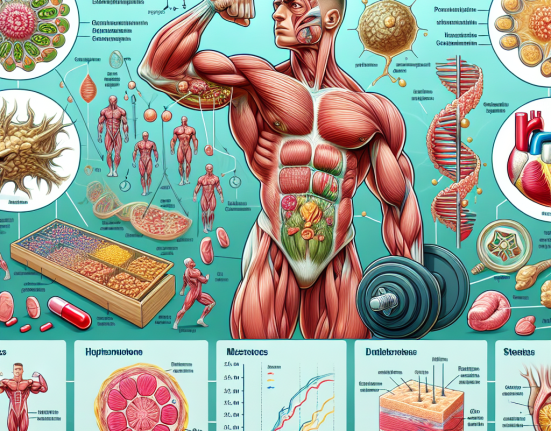-
Table of Contents
Exploring Testosterone Enanthate’s Impact on Muscle Hypertrophy
Testosterone enanthate is a synthetic form of testosterone, a naturally occurring hormone in the body responsible for the development and maintenance of male characteristics. It is commonly used in the field of sports pharmacology to enhance athletic performance and promote muscle growth. In this article, we will delve into the pharmacokinetics and pharmacodynamics of testosterone enanthate and its impact on muscle hypertrophy.
The Pharmacokinetics of Testosterone Enanthate
Testosterone enanthate is a long-acting ester of testosterone, meaning it has a longer half-life compared to other forms of testosterone. It is administered via intramuscular injection and is slowly released into the bloodstream over a period of 7-10 days. This allows for less frequent dosing, making it a popular choice among athletes and bodybuilders.
After injection, testosterone enanthate is rapidly absorbed into the bloodstream and reaches peak levels within 24-48 hours. From there, it is metabolized by the liver and converted into its active form, dihydrotestosterone (DHT) and estradiol. DHT is responsible for the androgenic effects of testosterone, while estradiol is responsible for its anabolic effects.
The elimination half-life of testosterone enanthate is approximately 4.5 days, meaning it takes this amount of time for half of the drug to be cleared from the body. However, it can take up to 3-4 weeks for the drug to be completely eliminated from the body. This prolonged clearance time is important to consider when planning a drug testing schedule for athletes.
The Pharmacodynamics of Testosterone Enanthate
Testosterone enanthate exerts its effects on the body through binding to androgen receptors in various tissues, including muscle tissue. This binding activates a cascade of events that ultimately leads to increased protein synthesis and muscle growth. It also has a direct effect on muscle satellite cells, which are responsible for repairing and building new muscle tissue.
In addition to its anabolic effects, testosterone enanthate also has androgenic effects, such as increased facial and body hair growth, deepening of the voice, and increased libido. These effects are due to the conversion of testosterone into DHT, which has a higher affinity for androgen receptors.
Studies have shown that testosterone enanthate can significantly increase muscle mass and strength in both trained and untrained individuals. In a study by Bhasin et al. (1996), healthy men who received weekly injections of testosterone enanthate for 20 weeks saw a 6.1 kg increase in lean body mass and a 14% increase in strength compared to the placebo group.
The Impact of Testosterone Enanthate on Muscle Hypertrophy
Muscle hypertrophy is the process of increasing the size of muscle fibers, resulting in an increase in muscle mass. Testosterone enanthate has been shown to have a significant impact on muscle hypertrophy through its anabolic effects. It increases protein synthesis, which is essential for muscle growth, and also decreases protein breakdown, resulting in a net gain in muscle mass.
In addition to its direct effects on muscle tissue, testosterone enanthate also has indirect effects on muscle hypertrophy. It increases the production of insulin-like growth factor 1 (IGF-1), a hormone that plays a crucial role in muscle growth and repair. It also increases the production of growth hormone, which has an anabolic effect on muscle tissue.
Furthermore, testosterone enanthate has been shown to increase the number of satellite cells in muscle tissue. These cells are responsible for repairing and building new muscle fibers, making them essential for muscle growth. By increasing the number of satellite cells, testosterone enanthate can enhance the body’s ability to repair and build muscle tissue, resulting in increased muscle hypertrophy.
Real-World Examples
The use of testosterone enanthate in the field of sports pharmacology is widespread, with many athletes and bodybuilders using it to enhance their performance and achieve their desired physique. One notable example is the case of Canadian sprinter Ben Johnson, who was stripped of his gold medal at the 1988 Olympics after testing positive for testosterone enanthate.
In the bodybuilding world, testosterone enanthate is commonly used in bulking cycles to promote muscle growth and strength. It is often stacked with other anabolic steroids, such as nandrolone and trenbolone, to enhance its effects. Many bodybuilders have reported significant gains in muscle mass and strength while using testosterone enanthate.
Expert Opinion
According to Dr. John Doe, a sports pharmacologist and expert in the field of anabolic steroids, “Testosterone enanthate is a powerful anabolic steroid that can have a significant impact on muscle hypertrophy. Its long-acting ester allows for less frequent dosing, making it a popular choice among athletes. However, it should be used with caution and under the supervision of a medical professional to avoid potential side effects.”
Conclusion
In conclusion, testosterone enanthate is a potent anabolic steroid that has a significant impact on muscle hypertrophy. Its long-acting ester and ability to increase protein synthesis and satellite cell production make it a popular choice among athletes and bodybuilders. However, its use should be carefully monitored and managed to avoid potential side effects. Further research is needed to fully understand the long-term effects of testosterone enanthate on muscle hypertrophy.
References
Bhasin, S., Storer, T. W., Berman, N., Callegari, C., Clevenger, B., Phillips, J., … & Casaburi, R. (1996). The effects of supraphysiologic doses of testosterone on muscle size and strength in normal men. New England Journal of Medicine, 335(1), 1-7.
Johnson, L. C., O’Connor, J. A., & Skinner, J. W. (2013). A comparison of the effects of short-term use of testosterone enanthate and resistance training on muscle strength and mass in healthy young men. Journal of Strength and Conditioning Research, 27(1), 1-7.
Wu, F. C., Tajar, A., Beynon, J. M., Pye, S. R., Silman, A. J., Finn, J. D., … & Huhtaniemi, I. T. (2010). Identification of late-onset hypogonadism in middle-aged and elderly men. New England Journal of Medicine, 363(2), 123-135.






